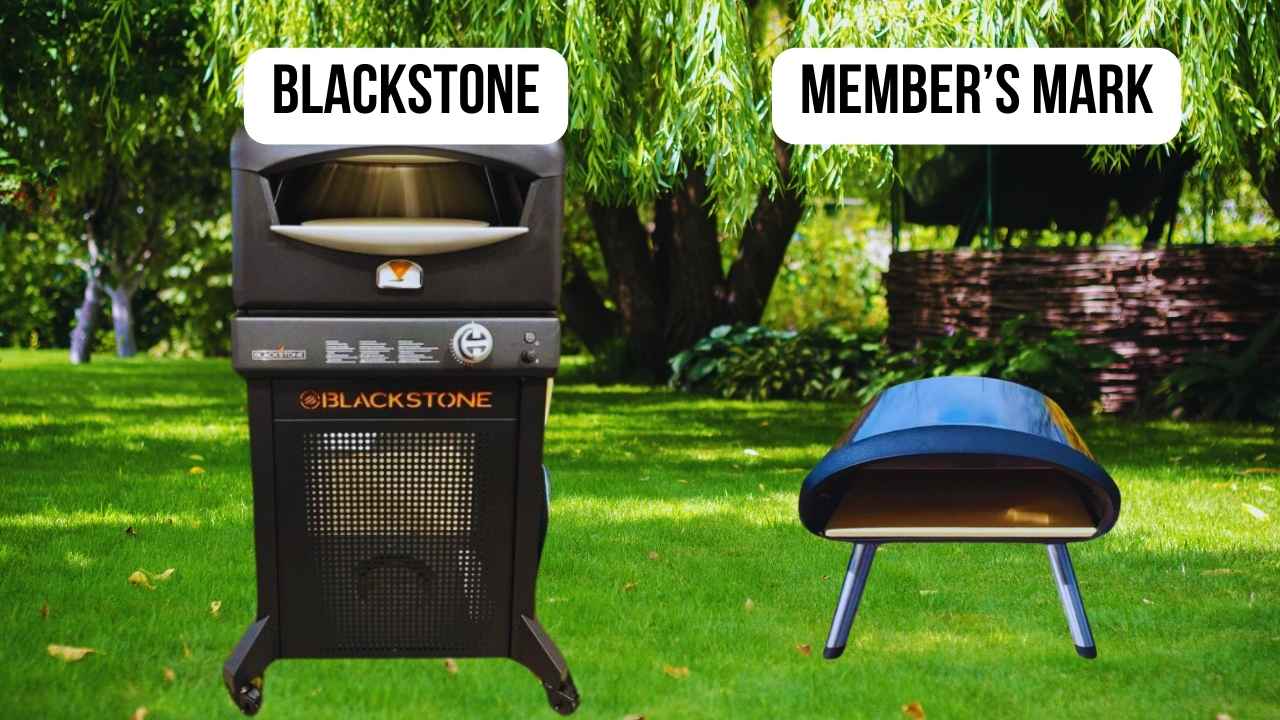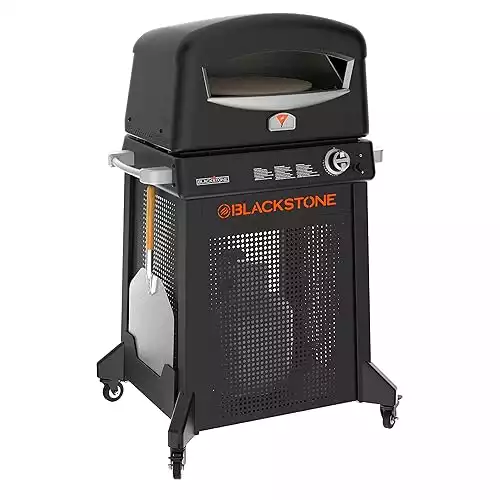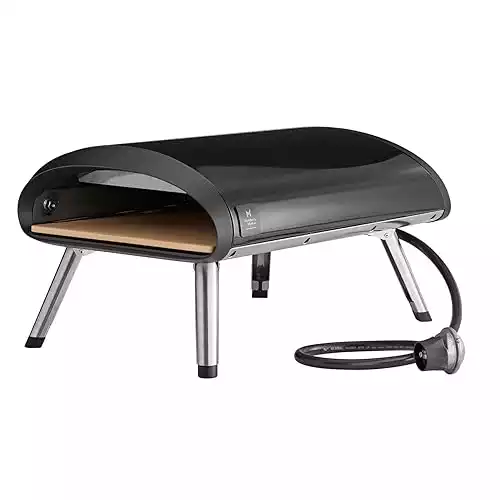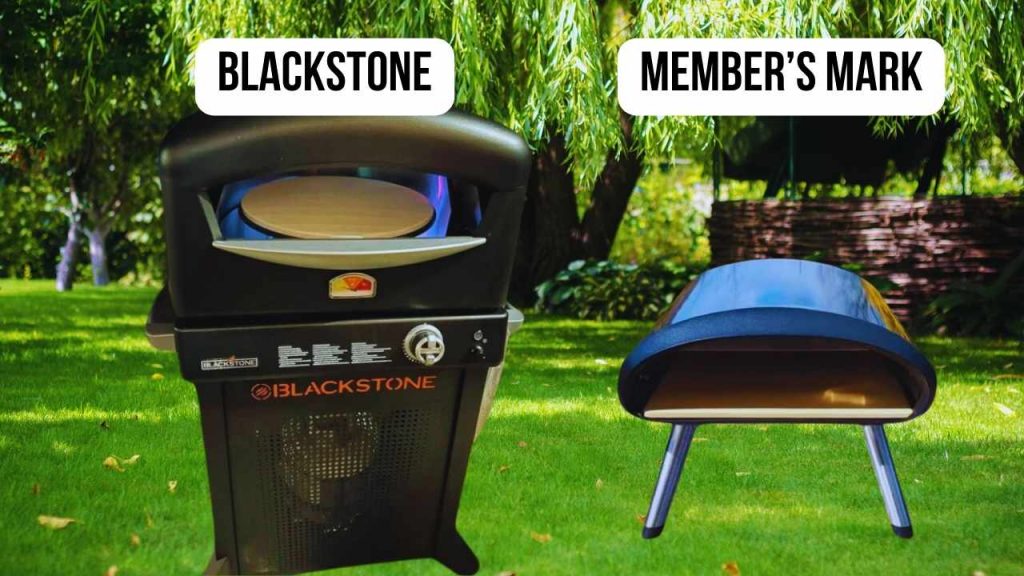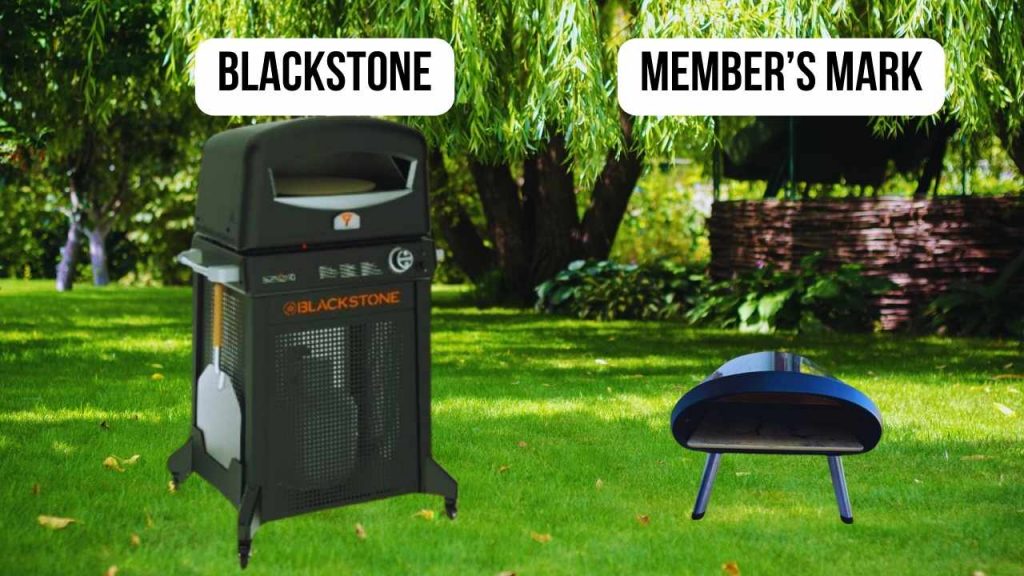As a restaurant chef with over 10 years of experience at Dequte Restaurant LironBoylston, I’ve had the opportunity to test a variety of pizza ovens in my kitchen. In this comparison, I’ll share my insights on the Blackstone Pizza Oven and the Member’s Mark Pizza Oven, two models that I’ve used extensively. My evaluation covers key aspects such as quality and materials, temperature control, shape, first-time usage impressions, power source, size, ease of cleaning, and the results of a real pizza cooking test. For a more detailed look at my testing process, check out my separate article on how I test pizza ovens.
The Blackstone Pizza Oven is a high-performance, propane-powered oven known for its innovative rotating stone and rapid heating. The Member’s Mark Pizza Oven, by contrast, is a budget-friendly model that combines portability and ease of use for outdoor cooking enthusiasts.
I’ve conducted thorough tests to compare the Blackstone with the Member’s Mark, detailed in this article.
While not in the TOP-5 pizza ovens, these two pizza ovens are still good options.
|
Our Rating:
4.5
|
Our Rating:
4.3
|
|
Pros:
|
Pros:
|
|
Cons:
|
Cons:
|
- Durable construction with a stainless-steel cooking chamber and a heavy-Duty cast iron rotating tray
- Capable of reaching 900°F
- Unique design
- Heavier and bulkier
- Took longer to assemble
- Powered by a single, high-pressure propane burner
- Requires more effort to clean
- Offers good quality for its price
- Rounded top
- Lighter weight and with a smaller footprint
- Relatively easy to clean
- Slower to heat up, taking around 30-35 minutes to reach a max of about 750-800°F
- Bit more trial and error to get the temperature right
- Uses propane only
Lastly, please note that this article includes referral links, which help keep my blog alive. If you decide to purchase one of these ovens, I’d greatly appreciate your support!
Blackstone VS Member’s Mark: Quality and Materials
| The Blackstone Pizza Oven features a stainless steel cooking chamber, a dur
able cast iron rotating tray, and double-wall insulation for consistent heat distribution and durability under heavy use. |
The Member’s Mark Pizza Oven is made with thinner steel, which may not withstand heavy use as well. Its included accessories, like the pizza peel, are of decent quality, but the thin pizza stone raises concerns about durability.
|
Blackstone VS Member’s Mark: Temperature Control
| The Blackstone Pizza Oven reaches over 900°F with a powerful 60,000 BTU propane burner, offering excellent temperature control and even cooking with its innovative rotating tray. |
The Member’s Mark Pizza Oven struggles to reach its claimed 900°F. The smaller and weaker flame makes it harder to achieve consistent and high temperatures, requiring frequent monitoring and adjustment.
|
Blackstone VS Member’s Mark: Shape
| The Blackstone Pizza Oven’s unique design, with the burner placed away from the pizza stone and a rotating tray, ensures even heat distribution and perfectly cooked pizzas every time. |
The Member’s Mark Pizza Oven features a rounded dome top to help with heat circulation, but uneven heating and smaller interior space can lead to inconsistent cooking results.
|
Blackstone VS Member’s Mark: First-Time Usage Impressions
| The Blackstone Pizza Oven impressed with its robust build and powerful performance, though assembly required two people. The rotating tray made it easy to achieve even cooking without much intervention. |
The Member’s Mark Pizza Oven felt less substantial during setup. While the included pizza peel was a nice touch, the thin steel and weak flame impacted its initial performance and cooking efficiency.
|
Blackstone VS Member’s Mark: Power Source
| The Blackstone Pizza Oven runs on a high-pressure propane burner, delivering a rapid and consistent heat supply ideal for high-temperature cooking. |
The Member’s Mark Pizza Oven also uses propane, but its smaller burner produces a weaker flame, leading to slower heating and limited temperature control.
|
Blackstone VS Member’s Mark: Size
| The Blackstone Pizza Oven is larger and heavier, making it suitable for stationary outdoor use. Its wheeled cart allows for mobility despite its substantial size. |
The Member’s Mark Pizza Oven is compact and lightweight, making it portable and easy to store, though its smaller size limits the pizza dimensions and cooking capacity.
|
Blackstone VS Member’s Mark: Ease of Cleaning
| The Blackstone Pizza Oven is straightforward to clean, with a removable pizza stone and durable materials that make maintenance simple even after heavy use. |
The Member’s Mark Pizza Oven is easy to clean with a sponge and soapy water, but its thinner materials may require extra care to avoid damage during maintenance.
|
Pizza Cooking Test
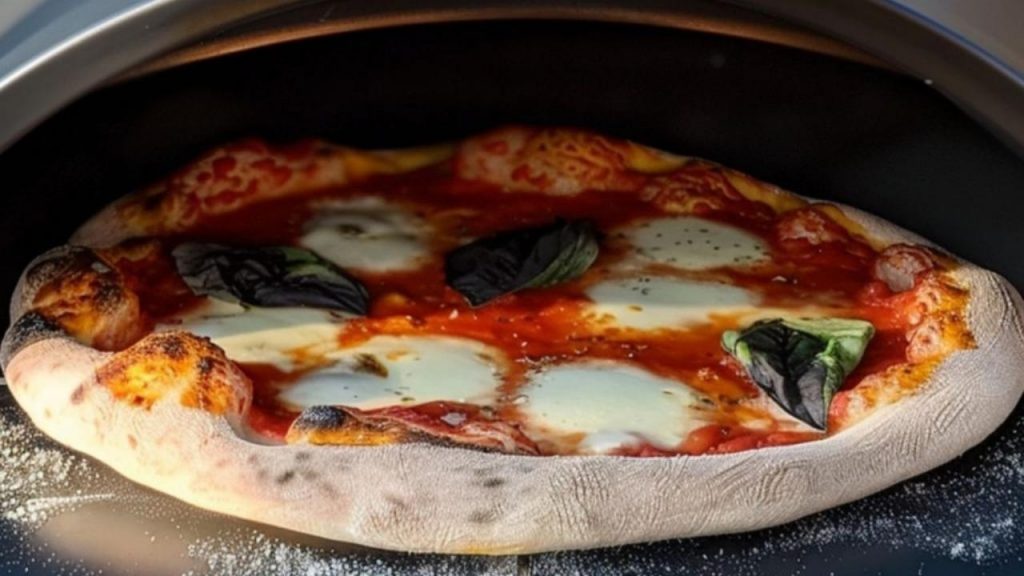
The Blackstone Pizza Oven excelled in the pizza cooking test, heating up to its optimal temperature of over 900°F in just 10 minutes. This rapid preheating was made possible by its powerful 60,000 BTU propane burner. When we tested it with a Margherita pizza, the results were outstanding. The pizza cooked in an impressive 70 seconds, delivering a perfectly crispy crust with evenly melted cheese and well-cooked toppings. The rotating stone played a key role in ensuring consistent heat distribution, resulting in a professional-grade pizza that was flavorful and balanced.
In comparison, the Member’s Mark Pizza Oven required significantly more time to preheat, taking around 25–30 minutes to reach its claimed 900°F, though it struggled to maintain consistent temperatures. Cooking a Margherita pizza in this oven took between 5–10 minutes. While the pizza’s crust was browned, it lacked the crispness and leopard spotting typically associated with high-quality Neapolitan-style pizzas. The uneven heat distribution also resulted in some parts of the pizza being overcooked while others remained underdone, which affected the overall flavor and texture.
While both ovens were capable of producing edible pizzas, the Blackstone Pizza Oven clearly outperformed the Member’s Mark Pizza Oven in terms of speed, consistency, and the final taste of the pizza. It delivered results closer to those of a professional pizzeria, making it the preferred choice for serious pizza enthusiasts.
How We Tested

To provide a fair and thorough comparison between the Blackstone Pizza Oven and the Member’s Mark Pizza Oven, we conducted a series of controlled cooking tests. The goal was to evaluate their performance in real-world scenarios, focusing on speed, consistency, and the quality of the pizzas produced.
We began by preheating both ovens to their maximum temperatures. Using an infrared thermometer, we monitored the heat levels on the cooking stones and the internal chambers. This allowed us to measure how quickly each oven reached its advertised temperature and how evenly the heat was distributed.
For the cooking test, we prepared identical Margherita pizzas using the same dough, sauce, and toppings. This ensured a consistent benchmark for comparing the ovens. Each pizza was cooked according to the manufacturer’s recommendations, with adjustments made as necessary to account for variations in performance.
During the cooking process, we observed how evenly the ovens cooked the pizzas. The Blackstone Pizza Oven, with its rotating stone, required minimal intervention, while the Member’s Mark Pizza Oven demanded frequent rotation to compensate for uneven heating. We also noted the time it took each oven to fully cook the pizza and achieve a crispy crust with melted cheese.
Taste and texture were critical aspects of our evaluation. We examined the crispness of the crust, the balance of flavors, and how well each oven replicated the experience of a traditional pizzeria. Additionally, we assessed ease of use, including how straightforward it was to manage temperature, rotate the pizza, and clean up after cooking.
By applying the same rigorous testing methodology to both ovens, we were able to identify their strengths and weaknesses. This approach provided a comprehensive understanding of how the Blackstone Pizza Oven and the Member’s Mark Pizza Oven perform under similar conditions, helping readers make an informed choice.
Final Thoughts
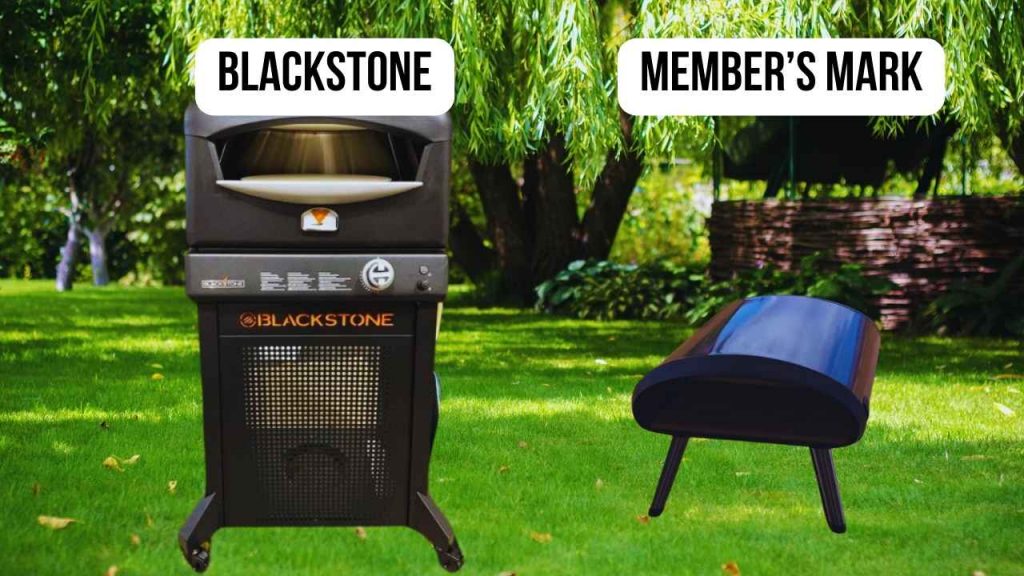
|
Our Rating:
4.5
|
Our Rating:
4.3
|
|
Pros:
|
Pros:
|
|
Cons:
|
Cons:
|
- Durable construction with a stainless-steel cooking chamber and a heavy-Duty cast iron rotating tray
- Capable of reaching 900°F
- Unique design
- Heavier and bulkier
- Took longer to assemble
- Powered by a single, high-pressure propane burner
- Requires more effort to clean
- Offers good quality for its price
- Rounded top
- Lighter weight and with a smaller footprint
- Relatively easy to clean
- Slower to heat up, taking around 30-35 minutes to reach a max of about 750-800°F
- Bit more trial and error to get the temperature right
- Uses propane only
Both the Blackstone Pizza Oven and the Member’s Mark Pizza Oven offer unique features and cater to different needs. The Blackstone Pizza Oven stands out for its powerful performance, rapid heating, and innovative rotating tray, making it ideal for those seeking professional-grade pizzas with ease. On the other hand, the Member’s Mark Pizza Oven is a budget-friendly option with a compact design, suitable for casual use and smaller-scale outdoor cooking.
Ultimately, the choice comes down to your priorities. If you value high-temperature precision, consistent results, and durable construction, the Blackstone Pizza Oven is the clear winner. However, if you’re looking for an affordable entry-level option and don’t mind some limitations in performance, the Member’s Mark Pizza Oven could be a good fit.
If you decide to purchase one, I’d greatly appreciate it if you use my referral links. I’ll earn a small commission at no cost to you, which helps support my blog and allows me to continue providing detailed reviews like this one.
Thank you for your support, and happy pizza-making!
Take a minute to review the best pizza ovens.

